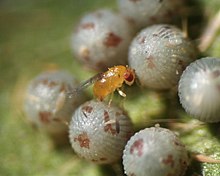| Trichogramma | |
|---|---|

| |
| Female Trichogramma dendrolimi on egg of armyworm (Noctuidae) | |
| Scientific classification | |
| Domain: | Eukaryota |
| Kingdom: | Animalia |
| Phylum: | Arthropoda |
| Class: | Insecta |
| Order: | Hymenoptera |
| Family: | Trichogrammatidae |
| Subfamily: | Trichogrammatinae |
| Tribe: | Trichogrammatini |
| Genus: | Trichogramma Westwood, 1833 |
| Species | |
|
230+, see text | |
Trichogramma is a genus of minute polyphagous wasps that are endoparasitoids of insect eggs.[1] Trichogramma is one of around 80 genera from the family Trichogrammatidae, with over 200 species worldwide.[2][3][4]
Although several groups of egg parasitoids are commonly employed for biological control throughout the world, Trichogramma spp. have been the most extensively studied.[5] More than a thousand papers have been published on Trichogramma species, and they are the most used biological control agents in the world.[6]
Trichogramma spp. are also of interest in neuroscience research, having fewer than 10,000 neurons, approaching the theoretical lower limit of the size of an insect brain, yet exhibiting complex behaviors to sustain their lives. [7]
- ^ Flanders, S; Quednau, W (1960). "Taxonomy of the genus Trichogramma (Hymenoptera, Chalcidoidea, Trichogrammatidae)". BioControl. 5 (4): 285–294. doi:10.1007/bf02372951. S2CID 34509414.
- ^ Consoli FL, Parra JRP, Zucchi RA (2010) 'Egg Parasitoids in Agroecosystems with Emphasis on Trichogramma.' (Springer).
- ^ Knutson A (2005) 'The Trichogramma Manual: A guide to the use of Trichogramma for Biological Control with Special Reference to Augmentative Releases for Control of Bollworm and Budworm in Cotton.' (Texas Agricultural Extension Service).
- ^ Sumer, F; Tuncbilek, AS; Oztemiz, S; Pintureau, B; Rugman-Jones, P; Stouthamer, R (2009). "A molecular key to the common species of Trichogramma of the Mediterranean region" (PDF). BioControl. 54 (5): 617–624. Bibcode:2009BioCo..54..617S. doi:10.1007/s10526-009-9219-8.
- ^ Upadhyay RK, Mukerji KG, Chamola BP (2001) 'Biocontrol potential and its Exploitation in Sustainable Agriculture: Insect Pests.' (Kluwer Academic/ Plenum Publishers).
- ^ Knutson A (2005) 'The Trichogramma Manual: A guide to the use of Trichogramma for Biological Control with Special Reference to Augmentative Releases for Control of bollworm and Budworm in Cotton.' (Texas Agricultural Extension Service).
- ^ van der Woude, Emma; Smid, Hans M. (September 2017). "Maximized complexity in miniaturized brains: morphology and distribution of octopaminergic, dopaminergic and serotonergic neurons in the parasitic wasp, Trichogramma evanescens". Cell and Tissue Research. 369 (3): 477–496. doi:10.1007/s00441-017-2642-8. PMC 5579201. PMID 28597098.